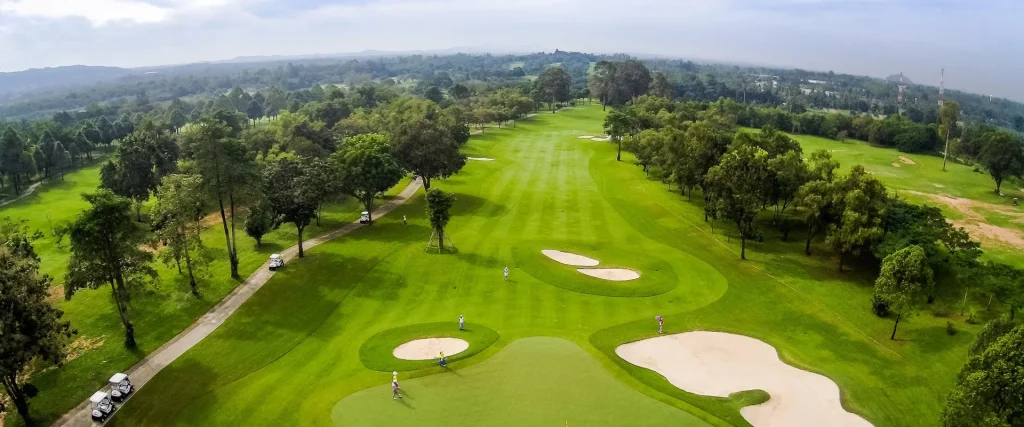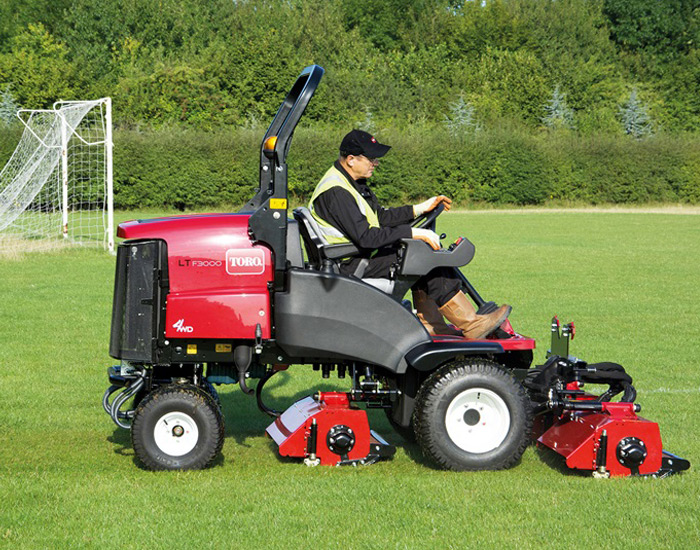Golf is beloved by enthusiasts around the world, but maintaining lush green courses in hot and humid environments like Southeast Asia can be an intense process requiring substantial water, fertilizers, and pesticides. As environmental awareness grows, golfers and course owners realize these maintenance practices carry a heavy ecological impact.
The good news is that more sustainable solutions exist – ones that provide excellent playing conditions while benefiting the planet. By implementing eco-friendly course management strategies, supervision teams can reduce expenses, preserve precious resources like water, and build value for their club.
Let’s explore some of the most impactful environmentally-conscious maintenance techniques tailored for Southeast Asian golf landscapes.
The Costs of Traditional Golf Course Care
Maintaining golf excellence has always required significant resources, but the environmental toll of traditional maintenance is no longer sustainable.
Key Issues of Conventional Golf Course Care
- Extensive water usage: Golf courses in hot climates can use over 6 acre-feet of water per acre per year, with 60-80% of this water used specifically for irrigating thirsty turfgrass areas.
- Chemical fertilizers: Artificial nutrients like nitrates and phosphates runoff into waterways, promoting algae blooms and aquatic weed growth.
- Pesticides: Chemical pests, weeds, and disease control products reduce biodiversity and contaminate groundwater.
Pursuing eco-friendly golf course management does come with potential hurdles, especially during initial transitions. Foreseeing these challenges is key to smooth adoption.
Routine practices like intensive mowing, uncomposted green waste, and bare soil exposure generate further ecological issues.
As environmental consciousness grows among golfers, expectations for sustainable course management rise. There are also growing economic incentives through government rebates and tax breaks for clubs adopting eco-friendly practices.
The good news is golf can be sustained far more harmoniously with nature through clever course design and earth-conscious maintenance procedures.
Sustainable Landscaping Fundamentals – Working with Nature
At its core, eco-friendly golf course maintenance focuses on harmoniously coexisting with natural ecosystems instead of combating them. This means preserving native flora and fauna while maintaining natural hydrology patterns and soil health.
Preserving Native Plant and Animal Species
Various methods can preserve native plants and animals on golf courses. An initial biodiversity survey should map out forests, wetlands, streams and habitats on the grounds. These areas can be protected through buffer zones to avoid disturbance. For example, a 50 meter radius around a wetland area can be planted with native grasses and flowers to support wildlife.
Native grasses suited to local climate and soils should also be used for fairways and roughs instead of imported varieties requiring more interventions. Landscaping around clubhouses and holes can incorporate indigenous ferns, orchids, and tree species like mahogany or palm for an authentic, eco-friendly plant palette.
Maintaining Natural Water Flows
Careful course design is also vital for maintaining natural stormwater and drainage flows across the landscape without human disruption. Consulting detailed watershed maps reveals the land’s hydrological patterns. The course layout should avoid conflicting with these established flows by positioning fairways and greens appropriately.
Soil composition tests also guide hole placements in areas that require minimal resource-intensive amendments. Installation of buffer zones around existing streams, rivers, and ponds preserves these riparian habitats. Allowing stormwater to follow its natural filtration path into the water table instead of diverting water to man-made drains sustains the local ecosystem stability.
Spotlight: How Westchester Country Club Aced Eco-Friendly Water Management
When Westchester Country Club in New York sought to implement more sustainable practices, they took a systematic approach to enhancing water quality across their 18-hole course spanning 200 acres.
“With large water bodies like ponds and streams plus plentiful drainage networks, we needed to address water holistically beyond just irrigation usage,” explains Westchester’s Chief Agronomist. “Issues like runoff contaminants, algae blooms, and erosion hotspots required integrated solutions to sustain water quality while eliminating chemical reliance.”
Key initiatives Westchester undertook include:
- Planting 20 hectares of buffer zones with native vegetation to filter runoff & stabilize banks
- Designating 200-meter organic-only spray zones around all water bodies
- Laser grading areas with poor drainage to maximize water absorption
- Introducing white amur algae-eating fish into ponds to control blooms naturally
Building Healthy Soil Biology
Building healthy soil biology without chemicals is also key. While nutrient levels are important, the complex food web of microbes, fungi, and earthworms keeps soil thriving. Regular soil tests monitor this microscopic life. Natural supplements like seaweed extracts, biochar, molasses, and compost teas add beneficial microbes, organic matter, and minerals to enhance fertility without toxic chemical interventions.
Earthworm populations over 500 per square meter indicate robust, living soil.
Reusing and Recycling On-Site
Finally, sustainable golf emphasizes reducing waste through reusing and recycling on-site. An on-site composting yard that processes clipping waste, fallen leaves, and kitchen scraps generates rich, nutritious fertilizer for the course without waste collection fees. Wood chips from native tree pruning can mulch planting beds to conserve moisture.
Rainwater harvesting tanks connected to drains and roofs allow stormwater to be stored and reused for irrigation instead of being withdrawn from natural water bodies.
Incorporating these fundamentals into course management makes significant environmental enhancements possible without compromising playability.
Green Golf Course Solutions
Let’s explore some of the most impactful earth-conscious solutions tailored for golf courses in hot and humid Southeast Asian environments.
Eco-Friendly Irrigation Techniques
As water scarcity intensifies globally, superintendents need clever irrigation methods that reduce consumption while keeping turfgrass healthy.
- Install central control systems: Networked systems like Toro Lynx allow intelligent water monitoring, identifying only thirsty areas instead of blanket watering.
- Shift to precision tools: Targeted sprinklers, rotors, and nozzles enhance water consumption efficiency.
- Collect rain & stormwater: Store excess precipitation in ponds and tanks for reuse.
- Treat & recycle wastewater: Using greywater for irrigation reduces potable water waste.
For example, the K-Rain Pro EX 2.0 controller from Jebsen & Jessen works as a standalone WiFi irrigation manager or remotely through internet connectivity. The unit adapts watering run times and schedules responsively based on real-time flow rates and climatic changes.
Likewise, the Toro Lynx central computer can consolidate all irrigation data into a single intuitive interface regardless of the equipment brands used across the course. This saves substantial time through automation while supporting better moisture management decisions.
Investing in these types of intelligent irrigation solutions pays dividends through water savings averaging 30-40%. And sustainable water use practices are crucial for delivering green, lush playing surfaces that appeal visually and environmentally.
Organic Fertilization
Maintaining lush green golf turf has always relied on liberal applications of quick-acting synthetic fertilizers to push rapid growth between uses. But, while visibility is effective in short-term, these artificial nutrients leach rapidly into soil and water systems. Runoff degrades local water bodies through uncontrolled algae and plant growth, which throws ecosystems out of balance.
Seeking to curb contamination, some courses attempted switching to slow-release pellet options with less rapid dispersion. However, the core dependency on imported external nutrients remains. Natural biological cycles become overridden to prioritize appearance perfection.
This reveals a need to shift the entire fertilization paradigm from artificial power-feeding to regenerating innate soil communities that continuously cycle nutrients. By honoring soil’s intricate web of microbes, fungi, and organic compounds, sustainable turfgrass can flourish through natural processes alone.
The solutions require a more patient, holistic approach:
- On-site composting: Recycling green waste into nutrient-rich compost cuts waste while enhancing turf health.
- Natural mineral amendments: Products like silicon, seaweed, and microbes strengthen turfgrass naturally.
- Microbial inoculants: Soil probiotics boost indigenous beneficial bacteria for better nutrient absorption.
- Slow-release organic fertilizers: Options like corn gluten and soy protein break down slower than synthetic fertilizers, avoiding chemical runoff.
Integrated Pest Management
Golf turf has also traditionally relied on potent chemical pesticides, herbicides, and fungicides to eliminate any issues threatening visual perfection rapidly. But, we now understand how persistent residues of these substances contaminate water sources and destroy beneficial insect species that provide natural biological control.
In response, some courses attempted to control pests using biopesticides derived from neem, garlic, or plant oils. However, these organic solutions still focused on the reactive destruction of targeted species instead of proactively cultivating prevention.
This reactive strategy fails to embrace pest outbreak catalysts as warnings that the wider ecosystem balance is disturbed. The objective is to heal those rifts by strengthening natural checks and balances. For instance, ladybug species prey on aphids that damage turf roots when their own habitat is not jeopardized by broad chemical use.
True integrated pest management requires holistic thinking:
- Select resistant turf varieties: Hardy, disease-tolerant grass breeds like Seashore Paspalum need fewer interventions.
- Enhance beneficial insects: Natural predators like ladybugs and wasps organically control pests.
- Apply organic biopesticides: Natural fungicides based on neem oil and benevolent microbes combat diseases safely.
- Use organic herbicides: Non-toxic vinegar-based weed killers avoid chemical toxicity issues.
Wildlife & vegetation conservation
A final component of eco-friendly golf course management is actively nurturing indigenous flora and fauna populations through habitat conservation initiatives.
Traditionally, courses sought to eliminate non-grass vegetation completely to maintain visual uniformity. Pesticides and herbicide applications denuded native plant varieties, while access restrictions hampered wildlife movement.
In response, some courses attempted to reintroduce vegetation by planting themed gardens around clubhouses. However, these tended to feature exotic ornamental varieties that offered limited ecological benefits.
Transforming golf courses into vibrant nature sanctuaries requires fully embracing coexistence with indigenous ecosystems. This means protecting and enhancing native species’ habitats integrated across the property.
Impactful efforts include:
- Safeguarding existing forest groves, wetlands, and riparian areas through designated buffer zones free of disturbances
- Reforesting cleared zones with tree species that once thrived before excessive landscaping
- Ensuring interconnected green corridors facilitate wildlife movement
- Installing nest boxes to attract threatened bird species
- Cultivating wildflower meadows with native saplings to regenerate decimated pollinator communities
Benefits of Eco-Friendly Golf Course Management
Transitioning to sustainable maintenance delivers compelling advantages:
Embracing Nature’s Beauty
Picture yourself stepping onto an emerald expanse as dawn breaks, the sun casting a golden glow upon a meticulously tended golf course. The air is crisp and clean, filled with the gentle melodies of chirping birds nestled in the flourishing native vegetation that fringes the playing area. Underfoot, the turf feels lush and springy, each blade of grass a testament to judicious irrigation practices that maintain optimal playing conditions while conserving precious water resources.
Harmonious Coexistence
As you traverse the course, you can’t help but marvel at the harmonious balance struck between the manicured fairways and the thriving ecosystems that surround them. Thoughtfully placed buffer zones and wildlife corridors provide sanctuary for a diverse array of flora and fauna, their presence adding to the richness of your golfing experience. Native wildflowers sway in the breeze, their vibrant hues a feast for the eyes while serving as a vital nectar source for pollinating insects.
Nurturing the Land
The very essence of the course speaks to a deep respect for the environment. Organic fertilizers and integrated pest management strategies nurture the soil and protect delicate ecological balances, ensuring that the land remains healthy and resilient for generations to come. The result is a playing surface of unparalleled quality – the greens rolling true and fast, the fairways an inviting carpet of green that beckons to be explored.
A Greener Future
As you sink your final putt and reflect on your round, you can take pride in knowing that your choice to play on an eco-friendly course contributes to a greener future. The sustainable management practices not only preserve the natural beauty of the landscape but also serve as a model for responsible stewardship of our shared environment. In this way, the simple act of enjoying a game of golf becomes an opportunity to celebrate and protect the magnificent outdoor spaces we cherish.
Partner with Jebsen & Jessen for Sustainable Success
As leaders in golf course irrigation, turf care, and eco-friendly solutions, Jebsen & Jessen helps clubs across Southeast Asia implement impactful sustainable practices through premium products and expert guidance.
Our water-saving Toro irrigation systems, organically optimized turf nutrients from leading manufacturers, and advanced Integrated Pest Management programs deliver world-class course conditions while benefiting the planet.
We invite golf course owners, committees, and superintendents to partner with the dedicated sustainability experts from Jebsen & Jessen’s Turf Solutions team. Discover how our specialized solutions portfolio assists clubs in enhancing environmental stewardship while elevating the member experience through gorgeously-conditioned fairways and greens.
Contact Jebsen & Jessen today to schedule a complementary sustainable course management assessment focused on your club’s unique ecosystem!



